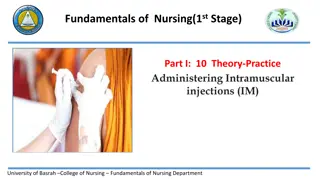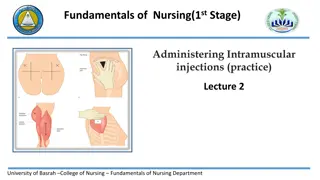Types of Injections and Their Uses
Injections, also known as shots, deliver medications, fluids, or nutrients directly into a person's body. Learn about different types of injections, including intravenous injections, and their purposes. Discover common injection sites and the importance of healthcare professionals in administering injections.
Download Presentation

Please find below an Image/Link to download the presentation.
The content on the website is provided AS IS for your information and personal use only. It may not be sold, licensed, or shared on other websites without obtaining consent from the author.If you encounter any issues during the download, it is possible that the publisher has removed the file from their server.
You are allowed to download the files provided on this website for personal or commercial use, subject to the condition that they are used lawfully. All files are the property of their respective owners.
The content on the website is provided AS IS for your information and personal use only. It may not be sold, licensed, or shared on other websites without obtaining consent from the author.
E N D
Presentation Transcript
StudyMafia.Org Injection Submitted To: Submitted By: Studymafia.org Studymafia.org
Table Contents Definition Introduction Types of Injections Conclusion 2
Definition Injections, also known as shots, deliver liquid medications, fluids, or nutrients directly into a person s body. 3
Introduction Several different types of injections exist, depending on the purpose of the medication or substance in the shot. A healthcare professional can inject many medications into many parts of the body. They will decide the most appropriate route of access depending on the situation. 4
Types of Injections Intravenous injections Healthcare professionals use intravenous (IV) injections to give medications directly into a vein. Because a person directly injects the medication into the bloodstream, it allows for rapid absorption, according to 2015 research. This causes an immediate response, per a 2019 review of the literature 6
Types of Injections They may use an intravenous injection to: administer fluid solutions and electrolytes to a person experiencing dehydration give local and general anesthesia to people having surgery or a procedure administer pain medications to a person in the emergency room or after surgery give blood or blood products to a person 7
Types of Injections They may use an intravenous injection to: administer nutrition to a person who is severely malnourished administer iron to a person with a severe iron deficiency administer contrast dye to a person having a special imaging test administer a steroid such as dexamethasone give chemotherapy to a person with cancer 8
Types of Injections Common IV injection sites areas where veins lie close to a person s skin include: the back of the hands the front and back of the lower arm the front elbow pit Doctors may use veins in the foot to administer IV injections to infants who have not started walking yet 9
Types of Injections Intramuscular injections Doctors can use intramuscular injections to deliver medication into a person s muscle tissue. The muscles have a rich blood supply, which helps the body absorb the medication quickly. 10
Types of Injections Common uses for intramuscular injections may include: administering most vaccines, per the Centers for Disease Control and Prevention (CDC) administering select antibiotics, such as penicillin and streptomycin giving corticosteroids for inflammation or allergic reactions 11
Types of Injections Common uses for intramuscular injections may include: administering hormones, such as testosterone and medroxyprogesterone administering drugs to patients who cannot take medications through other commonly used routes 12
Types of Injections The recommended intramuscular injection sites include: the upper outer thigh area muscle the shoulder muscle and upper arm the hip Doctors administering intramuscular injections avoid injecting into a patient s buttock area to prevent possible damage to the sciatic nerve 13
Types of Injections Subcutaneous injections Healthcare professionals administer subcutaneous injections into the fatty tissue just below the skin and above the muscle tissue. They will use a smaller needle to give subcutaneous injections to ensure the medication enters the fatty tissue and not the muscle. 14
Types of Injections Common uses for subcutaneous injections may include the administration of: insulin for diabetes heparin, or blood thinners the measles (MMR) and chickenpox (varicella) vaccines palliative care pain medications such as fentanyl and morphine 15
Types of Injections Common subcutaneous injection sites include: the outer side or back of the upper arm the front and outer side of the upper thigh the belly area 16
Types of Injections Intraosseous injections Intraosseous injections use a special needle to puncture the bone marrow in order to reach the veins. The bone marrow has a rich blood supply that connects straight to the circulatory system. 17
Types of Injections Intradermal injections Healthcare professionals give intradermal injections just below the surface of the skin, creating a small bump called a bleb or wheal. The intradermal injection route has the longest absorption time of all the different types of injections, according to a guide to clinical procedures published in 2015. 18
Conclusion People commonly use injected medicines in healthcare and home settings for the prevention, diagnosis, and treatment of various illnesses. Healthcare professionals can use injections to administer vaccines and other types of medications into a person s vein, muscle, skin, or bone. 19
References Google.com Wikipedia.org Studymafia.org Slidespanda.com
Thanks To StudyMafia.org























